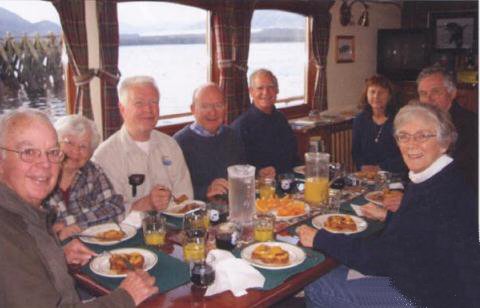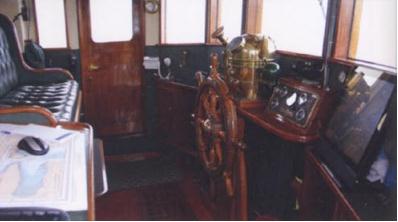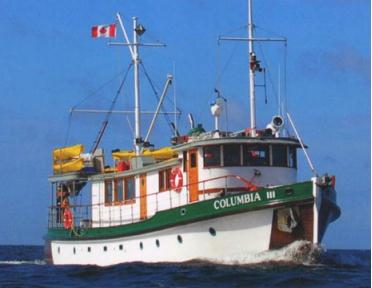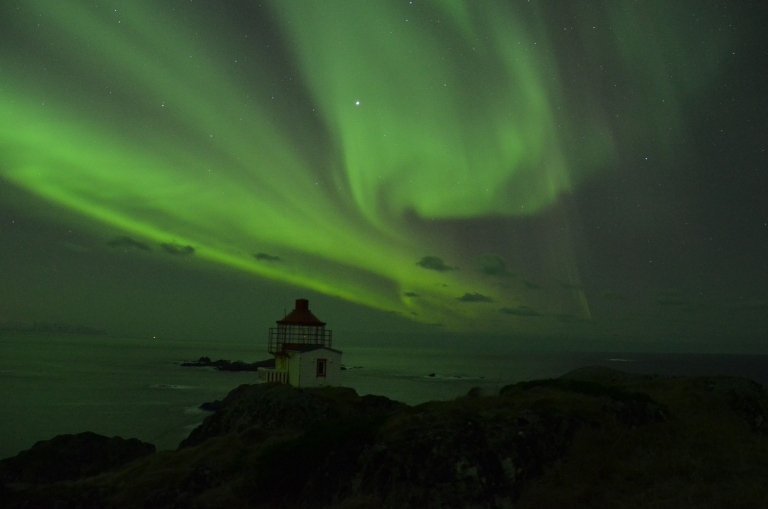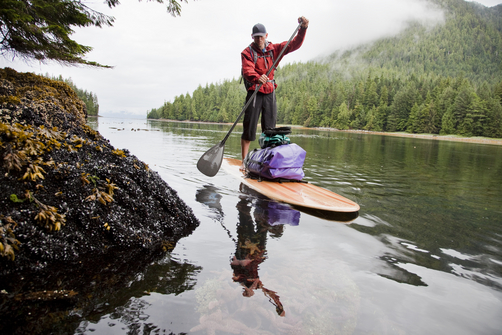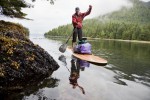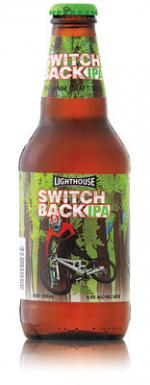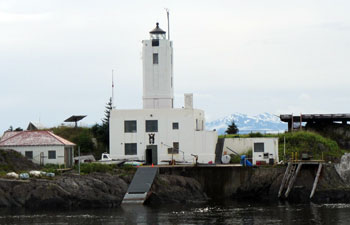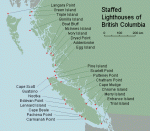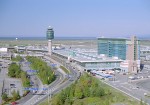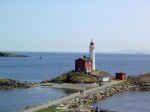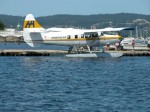On October 14, 2011 I wrote the article Thomas Crosby V – One of the “Bookboats” which described the church mission boat from the United Church of Canada. Now, a good friend Carol Jeffrey found a reference to a new mission boat, the Columbia III which worked for the Columbia Coast Mission from the Anglican Church. Below is a bit of information on this service to isolated posts on the BC coast , including lighthouses.
 Western Mariner Magazine December 2006
Western Mariner Magazine December 2006
– text from Jeanette Taylor1
While the headlines of Campbell River newspapers fumed over the millions of public dollars recently allocated for a consolidated mid-Vancouver Island hospital, a small crowd gathered at the city’s Discovery Harbour Pier for a tea celebrating the 50th anniversary of the launch of the hospital ship Columbia III. She was one of the last in a long line of
vessels operated by the Anglican Church’s Columbia Coast Mission. The Mission provided medical, non-sectarian religious and social services to remote settlements, lighthouses, logging camps and First Nations villages along BC’s inside coast from 1905 to the late 1960s.
The launch of Columbia III on October 13, 1956, took place at Star Shipyards (Mercer’s) in New Westminster, just 100 feet from where the second Columbia had been built hy the Dawes Shipyard in 1910. Robert Allan and his son Robert F. (Bob) Allan were in partnership as Vancouver naval architects when Columbia III was designed. Propulsion was a 182-hp Gardner 8L3 (still powering the vessel). Diesel generating and heating units were installed, as well as a propane sterilizer in the hospital cabin, x-ray machine, propane range and refrigerator in the galley and a Spilsbury & Tindall radio-telephone.
The coast has changed radically in the half century since the Columbia III glided down the launch-ways at Star Shipyard (Mercer’s) in New Westminster on October 13, 1956. That year a new hospital was in the offing for Campbell River and there were small hospitals established in Alert Bay and Powell River, but there were still hundreds of people living on the isolated coast between Sechelt and Seymour Inlet with little or no access to medical care or regular social contacts. No matter what the religious convictions of these people, the arrival of the Columbia was a welcome sight.

The Columbia Coast Mission saved hundreds of lives when its vessels hastened to logging camp accidents. The mission also provided a cherished social outlet. “It was very exciting when the Columbia came because there was very little entertainment for us,” remarked one of the attendees at the 50th anniversary tea held onboard Columbia III. In
those days the Columbia’s staff brought books, showed movies and hosted Christmas pageants, complete with a portly Santa Claus. Mothership Adventures, which offers eco and cultural tours in inside waters with the Columbia III, has had new owners since 2005, Ross Campbell and Fern Kornelsen of Sonora Island, and they welcomed the idea of the 50th celebration. The vessel’s aft double doors, designed originally to provide access for stretchers, were opened wide to a crowd which filled the saloon and aft deck to reminisce about the Columbia Coast Mission. The Campbell River stop came at the end of a 50th
anniversary voyage which originated in Port McNeill and threaded its way south with an enthusiastic group on board, all the members of which had past associations with the coastal ‘mission ships’. Along the way they revisited many homesteads, settlements and villages which had been regular stops during the Columbia’s service.Well aware of the Mission’s historic service Campbell and Kornelsen were pleased to return Columbia III to this part of the coast. But they weren’t prepared for the depth of feeling many still hold for the Mission and its ships. Wherever they tie up people have memories to share. On the recent anniversary cruise a young man asked the Columbia’s skipper to give a blast on the ship’s distinctive whistle as they passed the Alert Bay home of his 90-year-old grandmother, “for old time’s sake.” At the Whaletown wharf on Cortes Island, once frequented by the Coast Mission vessels, a small crowd gathered to watch Columbia III pull alongside. “I got a call from a neighbour,” said Jan Boas. “She said, ‘The Columbia is coming!’
This summoning call was heard frequently on this coast in days gone by. Prior to the advent of the Columbia Coast Mission in 1905 there were more than 100 isolated logging camps and settlements scattered along the coast and accidents were alarmingly common. The only hope, in the case of serious injury, was to row out into one of the main passages in an often futile search for a passing freight or passenger steamer. A lucky few
survived under these circumstances. The arrival of four dead loggers in Vancouver on a steamer galvanized the Mission’s founder, Reverend John Antle, into action. He persuaded his church to launch the first Columbia and later raised funds for four hospitals throughout the region.
By the time the Columbia III was launched in 1956, the coast was undergoing rapid change. Timber licences were being awarded almost exclusively to large companies, cutting out the smaller operators. This, and greater utilization of float planes over sea-going vessels and the establishment of highways and ferry connections between coastal centres, began to depopulate the coast. By the early 1960s only a hardy few still lived in isolation. Even the chaplains from the Mission took to the air in a Cessna floatplane, a practice which continued through the 1970s.
A gathering on the foredeck of the Columbia III, Kingcome Inlet in the 1960s. Judging by the
finery and the babe in mother’s arms and the Columbia Coast Mission chaplain to right in photo, this was probably a christening ceremony
The last sea-going chaplain with the Columbia Coast Mission, Rev Ivan Putter, arrived in 1965. He had a Decca radar installed so, while the Columbia III was by then serving as mobile aviation fuel rendezvous and a base of operation for the plane which could branch out to isolated pockets of the coast, the vessel continued to help the sick and injured and save lives when the plane was fogbound. However in 1967 the Columbia III was put up for sale. By 1982 the Mission had ceased operation.
Columbia III then passed into the hands of a string of owners and was a liveaboard in False Creek in Vancouver and in a pretty run-down condition when acquired by Bill McKechnie of Victoria in 1990. He worked with shipwright Paul Heron and several Victoria craftspeople on a well-thought-out and classy refurbishment. Original areas such as the doctor’s office and galley were reconfigured and, below decks, the chapel, chaplain’s stateroom and infirmary were converted to cabins and accommodation for 10 berthed passengers and crew members. McKechnie also started Mothership Adventures, a successful ecotourism venture which enabled Columbia Ill’s guests to explore wilderness areas of the mainland around the Broughton Archipelago and the Central Coast through a combination of cruising and kayaking.
A group of people, all with an association with the mission ships, revisited some of the old
haunts between Port McNeill and Campbell River in early October, 2006. Here they are
seated in Columbia Ill’s main saloon, the former hospital cabin. The large bright windows
and mahogany cabinetry and furnishings were part of the extensive 1990s refurbishment
overseen by owner Bill McKechnie in Victoria.
The inset photos show the wheelhouse and the engine room with the 8L3 Gardner that was in Columbia when launched 50 years ago.
Mothership Adventures and Columbia III were sold in the early 2000s to a Seattle owner who intended continuing the business in BC waters. However, he couldn’t make his way around the Canadian 60-ton master’s ticket requirement for Columbia III. Meanwhile Ross Campbell and Fern Kornelsen, who had fallen short in their attempts to buy Mothership Adventures from Bill McKechnie, continued to make it abundantly clear to the US owner that, if he wanted to sell, they would buy. They became owners in early 2005.
The Columbia III in her role as a ‘sea kayaking mothership’.
“The Columbia is always welcome wherever we pull in,” says Ross Campbell. “We feel we are custodians of a significant vessel in BC’s maritime heritage and we try to live up to her good name.”
In that spirit Campbell and his family have agreed to make the ship available for weddings and memorial services for the many people who hold the Columbia’s memory dear. And, Ross adds, “We’ll be working to give her another 50 years on the coast.”
************************************
 Here is a story from The Evening Citizen, Ottawa, Friday November 27, 1953
Here is a story from The Evening Citizen, Ottawa, Friday November 27, 1953
Vancouver (CP)-A missionary of the sea plays a vital part in the lives of 4,000 persons along the lower British Columbia coast.
From inlet to inlet, the mission ship Columbia II skippered by Capt. George A. MacDonald, a friendly 70-year-old Vancouver man, brings spiritual and physical comfort to loggers, fishermen and settlers in some 225 isolated communities.
The sturdy 100-foot diesel-driven ship plies from Stuart Island and Cape Scott at the northern tip of Vancouver island.
Veteran Chaplain
The chaplain is Canon Heber Greene, a veteran missionary, and the ship’s medical facilities are directed by Dr. J. G. Kempff.
In the tiny chapel, there have been weddings, christenings, confirmations, and funeral services.
“We handle hatches, matches and dispatches,” says a crew member.
The ship is one of four operated by the Columbia Coast mission of the Church of England in Canada.
Many mercy missions are undertaken by the 48-year-old Columbia. Last year she logged 31 emergency calls for sickness and accident cases.
“Calling the Columbia” is a frequent call over the ship’s radio-telephone, coming from the coastal districts dotting the rocky island shoreline.
One Mishap
She takes nine six-week cruises a year, and only once has she suffered a mishap. In 1948 she piled onto a reef in Warner Bay and was laid up some six weeks for repairs.
Capt. MacDonald has been with the Columbia for 17 years. With him he has engineer Bob McCree, Jack Owens as cook, and Bob Anderson, deckhand.
Off the main deck is a two-bed hospital equipped with examination table, dental chair, drugs and surgical instruments. Only minor operations are performed. Serious cases are taken to hospital at Alert Bay, the Columbia’s home port, 225 miles northwest of Vancouver.
There are recreational comforts too. There is a reading room, much used by lonely settlers, and a movie theater, where various films are shown during visits to upcoast ports.
“We feel we cover the whole life of the people,” said Canon Alan Greene, superintendent of the mission and brother of the Columbia’s chaplain.
Better Than Planes
Talk of the mission ship being replaced by an airplane gets little sympathy from mission authorities.
Storms and fogs have been battled by the Columbia on mercy missions. Under similar bad weather, a plane would be grounded.
“The plane lacks the personal touch,” added Canon Alan Greene, and his views are shared by Captain MacDonald.
The first mission boat was launched by Rev. John Antle in 1905 when Columbia Coast Mission was founded. It voyaged for man years along the coast, was replaced by the Columbia II. The old and expensive Columbia II, too, may be replaced, this time by a smaller vessel.
Of the 13,259 miles covered by the Columbia in 1952, 1, 295 miles were logged on emergency calls. She made a total of 1,047 calls, during which 807 cases were treated. Her sister ship, the John Antle, the Rendezvous, and the Veracity, travelled 6,000 and 5,383 miles, respectively. Three vessels are confined to mission work only.
Such coverage entails an annual expenditure of $75,000, most of which is incurred by the Columbia. The Community Chest of greater Vancouver bears the major part of the ship’s operating expenses, with the provincial and federal governments contributing small grants. The balance is provided through church contributions and private donations.
****************************
FOOTNOTE:
1 Jeanette Taylor is a Quadra Island-based writer and interpreter of BC coastal history and heritage. She has worked with the BC Archives aural history division and held curatorial and programming positions with the Campbell River Museum. She is the author of River City: A History of Campbell River and the Discovery Islands (1999, Harbour) and Exploring Quadra Island: Heritage Sites
and Hiking Trails (2001, Harbour) and is writing a history of the Discovery Islands and adjacent inlets.


